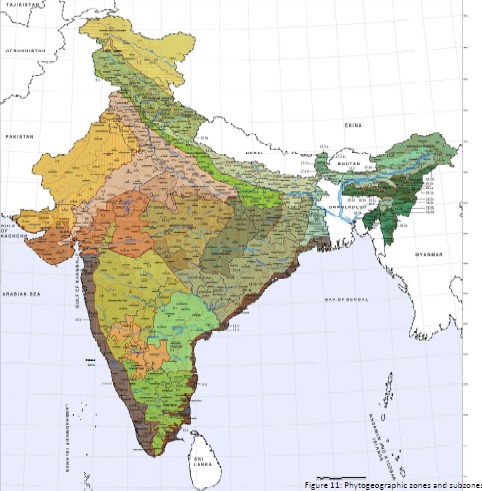
THE BOOK
PREVIEW
India, a country abundant in biodiversity, boasts a diverse array of bioclimates and vegetation types. Its landscape encompasses a wide range of environments, from the frigid deserts of Ladakh to the arid plains of Thar, and from the lush tropical evergreen forests of the Western Ghats to the deciduous forests in the Deccan Trap. With its varied physiography, including mountains, valleys, fertile plains, deserts, seas, oceans, plateaus, rivers, estuaries, swamps, and deltas, India spans almost all major climatic zones found in the world. The distinctive characteristics of these bioclimatic zones, influenced by factors such as temperature, water, light, wind, and soil, provide different growth conditions for various plant communities.
The book, entitled “Indian Plantarum – a compendium of Phytogeographic Zones and plant lists,” focuses on the interplay of these factors in delineating the bioclimatic zones, referred to phytogeographic zones, across the country. There are 20 zones and 79 sub-zones. These are portrayed through detailed maps, offering a comprehensive understanding of the distribution of plants and their growth potential in different areas. The book is organized into three chapters.
TABLE OF CONTENTS
01
Chapter 1
Deals with India's intricate climatic nuances, exploring the pivotal factors influencing plant growth, an array of vegetation types, and an in-depth study of the country's 20 phytogeographic zones and 79 subzones; supported with diagrams and maps.
02
Chapter 2
It dissects the distribution of the zones, offering a state-wise breakdown and providing concise descriptions of each zone's distinctive characteristics. Notably, key cities are prominently marked on the maps, simplifying the task of identifying which plants are best suited for specific regions.
03
Chapter 3
It offers a profound dive into the nuanced characteristics and exhaustive plant lists for each subzone, including critical data on soil types, precipitation patterns, temperature ranges, length of growing periods (LGP), geographical distribution, and dominant vegetation types. This chapter is framed around ecological zones rather than political state boundaries, ensuring accessibility and user-friendliness. Furthermore, the plant lists are categorized into Trees, Shrubs, Herbs, Creepers/Climbers, Grasses, and Others, with native species marked by an asterix.
ABOUT ME
Deepa Maheshwari
Landscape Architect, Botanist
I am a landscape architect and botanist, holding a Doctorate in Botany from North Gujarat University in 2007, a Master's in Landscape Architecture from the School of Planning and Architecture (SPA) in Delhi in 1990, and a M.Sc. in Botany from Delhi University in 1988. My journey in these fields began under the tutelage of my father, a luminary in the landscape design industry and nursery business in Delhi. His influence instilled in me a profound love for plants and the natural world, a passion that continues to drive my career.
As my professional path unfolded, I had the privilege of refining my expertise under the guidance of two distinguished mentors, Professor Prabhakar B Bhagwat and Professor Mohammad Shaheer. This knowledge foundation was further enriched through my extensive teaching tenure spanning over three decades at CEPT University. My areas of expertise encompass planting design, phytogeography, ecology, and regional landscape planning. My dual roles as an educator and practitioner have afforded me the opportunity to traverse India, gaining invaluable insights into the nation's diverse flora and landscapes. This inquisitiveness and experience have honed my keen eye for identifying plants, understanding their habitats, and observing their occurrences across various regions of the country.
During my tenure at CEPT University, I had the privilege of serving as the Program Chair for the Master's Program in Landscape Architecture for seven years. Additionally, I have organized national and international conferences and seminars, presented scholarly papers at conferences worldwide, and delivered lectures at various national platforms. My contributions extend to serving as a jury member for competitions, external expert for Ph.D. evaluations and PhD panel member, Jury for thesis and studios at institutions across India. I am proud to have been a founding member of ISOLA, the Indian Society of Landscape Architects. I have undertaken numerous professional projects that reflect my commitment to enhancing the natural and built environments.

